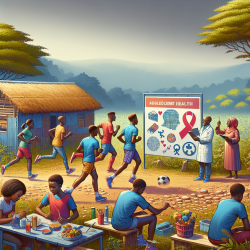Understanding Health Risk Behaviors in Adolescents
Adolescence is a critical period marked by rapid physical, cognitive, and emotional changes. In Sub-Saharan Africa, where HIV prevalence is significant, understanding health risk behaviors (HRB) among adolescents is crucial. A recent study titled Beyond Their HIV Status: the Occurrence of Multiple Health Risk Behavior Among Adolescents from a Rural Setting of Sub-Saharan Africa sheds light on this issue.
Key Findings from the Study
The study conducted in rural Kenya among 588 adolescents revealed that health risk behaviors cluster into distinct patterns, influenced by factors such as age, mental distress, and neighborhood safety. Interestingly, the study found no significant differences in HRB patterns across different HIV status groups, suggesting that these behaviors are influenced by broader socio-environmental factors rather than HIV status alone.
Implications for Practitioners
For practitioners working with adolescents, particularly in regions with high HIV prevalence, these findings offer valuable insights:
- Screening and Interventions: Implement regular screening for mental health issues and executive functioning deficits. Addressing these can mitigate the risk of engaging in HRB.
- Community Involvement: Engage family members and communities in interventions to create a supportive environment that addresses psychosocial risk factors.
- Focus on Executive Functioning: Strengthening cognitive skills such as working memory can be protective against HRB. Consider incorporating cognitive training programs in educational settings.
Encouraging Further Research
While this study provides a foundational understanding, further research is needed to explore the mechanisms of HRB clustering and its long-term impacts. Practitioners are encouraged to contribute to this growing field by conducting localized studies and sharing findings through professional networks.
Conclusion
Understanding and addressing health risk behaviors in adolescents is vital for improving health outcomes, particularly in regions heavily impacted by HIV. By leveraging research findings and engaging communities, practitioners can make a significant difference in the lives of young people.
To read the original research paper, please follow this link: Beyond Their HIV Status: the Occurrence of Multiple Health Risk Behavior Among Adolescents from a Rural Setting of Sub-Saharan Africa.










